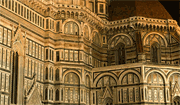The families who shaped the dominant courts in Renaissance Italy wanted more than just political influence and power. Guided by the era’s new vision of man and his potential for achievement, they also sought to express their sway through patronage of art, architecture, and literature.
Under dynasties such as the Medici, Sforza, Este, Gonzaga, and Montefeltro, the great cities of Florence, Milan, Ferrara, Mantua, and Urbino flourished in both art and commerce. This fertile ground, in turn, helped nurture the prodigious talents of such great artists as Piero della Francesca, Andrea Mantegna, Michelangelo, Leonardo da Vinci, and Raphael in the visual arts, Castiglione and Machiavelli in literature, and many other renowned Renaissance geniuses.
Elaine Ruffolo, Renaissance art historian at Syracuse University in Florence, explores this fascinating period of the Italian Renaissance.
9:30 to 10:45 a.m. Milan
Two ruling families, the Viscontis and Sforzas, created a cosmopolitan city and a system of patronage that supported artists including Leonardo da Vinci and Donato Bramante.
11 a.m. to 12 p.m. Ferrara and Mantua
Ercole II d’Este, Ferrara’s duke, was one of the period’s most important supporters of the arts. Under his rule, music and science flourished. A Titian portrait captures the essence of the power of Frederico II Gonzaga, Duke of Mantua, another noted patron.
12 noon Lunch (Participants provide their own.)
1 to 2 p.m. Urbino
Federico da Montefeltro, Duke of Urbino, invited many artists and writers to his court, including painter Piero della Francesca.
2:15 to 3:15 p.m. Florence
The birthplace of the Renaissance was eventually ruled by the Medicis, who positioned themselves at the center of the city’s political and cultural life—and of the papacy.
Other Connections
An excerpt from the BBC documentary The Medici: Makers of Modern Art looks at some of the Florentine architecture and art that sprang from the family’s mix of money, civic influence, and
image-making—plus in one case, a bid for personal salvation.
 Explore the birthplace of the Renaissance on tour—
Explore the birthplace of the Renaissance on tour—
Insider's Florence.
Visit the Smithsonian Journeys page to see more
European trips.